| Skånska vattentornssällskapet - Urbanmorfologi Scanian Water Tower Society - Urban Morphology |
| Hem | Vattentorn - Water Towers | Ebers vattentorn | Eber's Water Towers | Observandum |
Vattenblandat |
aVA |
| VA-historia | VA-Profiler | VA-artiklar | VA-litteratur | Akvedukter | Däxlar | Diverse VA | Gästsidor | Länkar |
| The leading trade paper in Sweden VA-tidskriften Cirkulation has a series about water towers under the headline Ebers vattentorn (Eber's Water Towers). Here are the same pictures and texts (translated) of interesting water towers in the world except Scania and Sweden, as in the journal. |
| Austria | Belgium | Denmark | The Czech Republic | Estonia | Finland | France | Germany | Great Britain | Hungary | Italy |
| Latvia | Lithuania | Luxembourg | The Netherlands | Norway | Poland | Portugal | Spain | Switzerland | USA |
| Eber's Water Towers: Italy |
| by Eber Ohlsson |
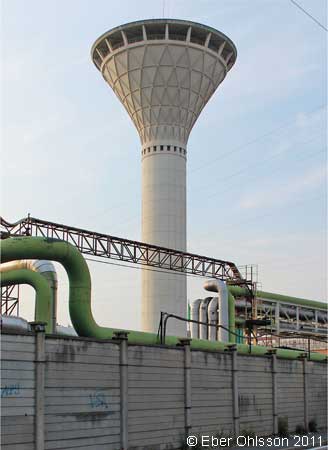 No 1/2024 Turin |
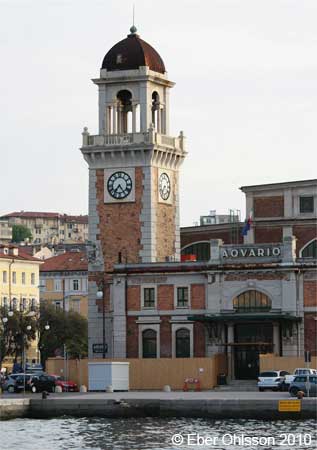 No 6/2021 Trieste |
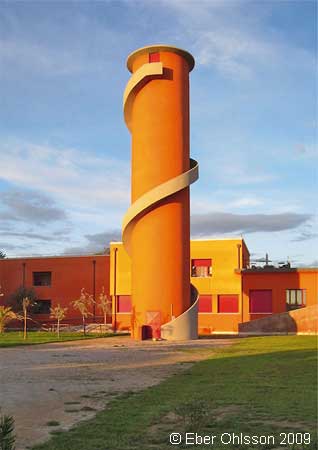 No 5/2018 Calambrone |
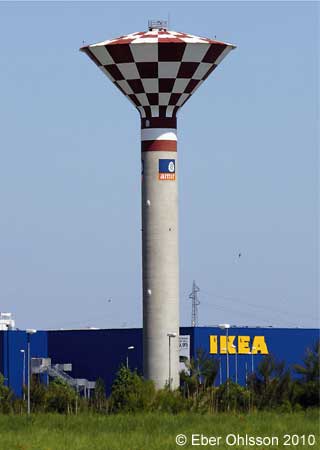 No 1/2015 Rimini |
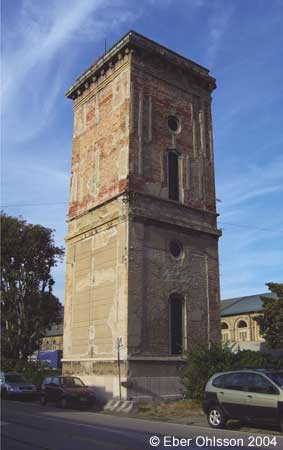 No 1/2013 Trieste |
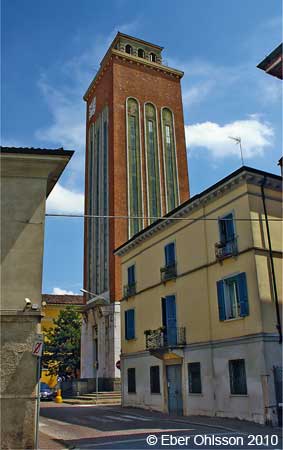 No 5/2011 Casal-maggiore |
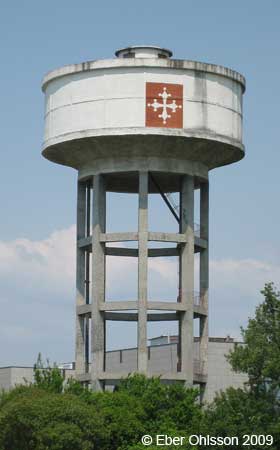 No 6/2009 Pisa |
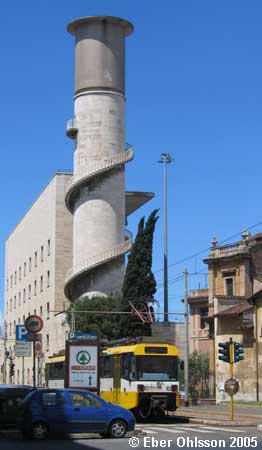 No 4/2008 Rome |
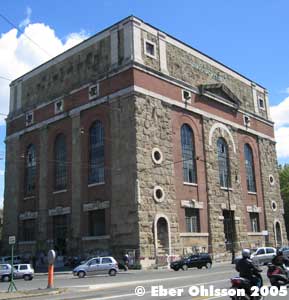 No 4/2007 Roma |
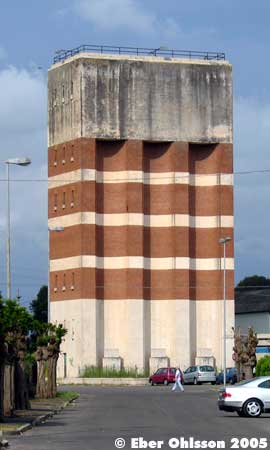 No 6/2006 Pontinia |
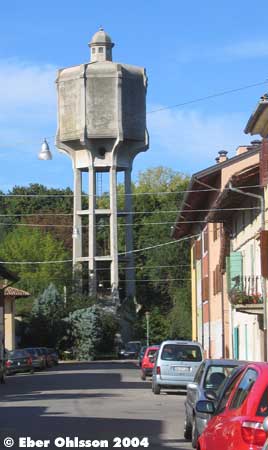 No 4/2005 Palmanova |
 |
Cirkulation 1/2023 A free translation to English: Pier Luigi Nervi was a famous engineer in Italy, as with his sense of the aesthetics also came to shape many prestigious buildings, such as Rome's Olympic Stadium for the Olympics in 1960 and the UNESCO building in Paris in 1950. His distinguishing mark became concrete buildings with an advanced and often visible structure. 'Fabbrica Italiana Automobili Torino', a company that is better known under the acronym FIAT, has since 1968 a water tower standing inside its large factory Mirafiore in south Turin, a water tower, designed by just Pier Luigi Nervi. The water tower reservoir has the typical exposed concrete structure, as Nervi is known for.
|
 |
Cirkulation 6/2021 A free translation to English: A water tower is assumed to supply drinking water to the subscribers, but there are exceptions to this rule, although it is very unusual. In the Italian city of Trieste on the Adriatic Sea is in the harbor an Art Nouveau building from 1913, which was formerly a fish market. The building's tower, which gives the impression of being a bell tower, however, is a water tower. The reservoir contained salt water, which was delivered to the market fishmongers, so they could keep their merchandise fresh. Now is the fish market gone and the building is partly an aquarium since 1933 and also an exhibition hall.
|
 |
Cirkulation 5/2018 A free translation to English: Angiolo Mazzoni, who was an engineer and architect of the National Post Office and the National Railways in Italy during the fascist period, designed two holiday camps, one for post and one for railway-employees' children. The modernistic establishments, with a water tower in futuristic architecture, were completed in 1931. They are located in the seaside resort Calambrone at the Pisa-coast, north of Livorno. The tower was a precursor to the water towers, which he later designed at Stazione Termini in Rome The holiday camps that was called Colonia Rosa Maltoni Mussolini after Benito Mussolini's mother, is now privatized and modernized.
|
 |
Cirkulation 1/2015
A free translation to English: Who gets the most attention? In a modern world, there is always signals that demands your attention. This can apply to commercial activities, such as the furniture store at the picture, with Swedish roots and with their colors manifests precisely this origin. It can also apply to an activity such as water supply, as the water tower at the picture on the outskirts of Rimini, Italy. With its painted checkerboard pattern and its height, the tower catches the eye. It will perhaps be an equable battle in attention. Financially, the store will however probably get more benefit of your attention than what the Rimini water companies Amir get.
|
 |
Cirkulation 1/2013
A free translation to English: When we today look at Austria and Hungary on the map, we see landlocked countries. But that was not the case a century ago. At that time the dual monarchy of Austria-Hungary had both coasts and ports on the Adriatic. The Habsburg Empire large export and import port was the city of Trieste. That is one of the reasons why you today in Trieste harbor find many beautiful, more than 100 years old port warehouses and one old water tower, all reminiscent of the empire's heyday. The cosmopolitan city, which in more than 500 years belonged to Austria, came after World War I to be part of Italy and serve a reduced area.
|
 |
Cirkulation 5/2011
A free translation to English: Po Valley is a fertile region and Italy's main industrial centers. On the plain meanders the Po river, the country's longest river and alongside the river, twenty km from Parma, is the city Casalmaggiore situated beneath an embankment to protect against river flooding. In the city center was built during the fascist period a water tower, "Torre Littoria", a name manifesting the then political regime. The architecture is typical of the contemporary public buildings. The square tower, which was completed in 1936, has side length 9 m and a height of 40 m. Today, the tower has only a mobile phone mast function.
|
 |
Cirkulation 6/2009
A free translation to English: There are water towers that fulfil its function, without to get any attention - so far they supply good water with an adequate pressure. Such a water tower is there in the Italian city Pisa, there however this water tower broke the anonymity by wearing the arms of the city. In the same city is there an another tower that not supplies the citizens with water, and moreover leans because it is insufficiently piled in a ground consist of sand, clay, gravel and under that blue clay. In other words a tower that not has been as it was planned. But this tower got more attention. There is no gratitude in this world.
|
 |
Cirkulation 4/2008
A free translation to English: Stazione Termini, Rome Central Station, is named after one of the Roman large baths, Diocletianus thermae, there baths was going on in alternating warm and cold water. On the opposite part of the station area is there two flank water towers that ought to have delivered cold water to the locomotives, water that thereafter was heated. The water towers are drawn by chief engineer and chief architect Angiolo Mazzoni that was inspired by the Constructivist architecture style. The towers as well as the renewal of the station were a work on the eve of the great World Exhibition 1942 in Rome, an event that however comes to nothing.
|

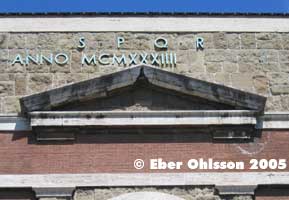 |
Cirkulation 4/2007
A free translation to English: In The Eternal City Rome, the old and the new are mixed. At Porta Maggiore there are many old aqueducts, but even a 70 year old water tower. The tower has inscriptions above a temple gable. Uppermost the acronym SPQR, Senatus Populusque Romanus (The Senate and the Roman people) used under the Roman Empire as well as in modern time. Under the SPQR there is an asymmetric time denunciation; 1934 in Latin letters, as well as a vacant space. The year of the vacant space, EF XIII, is able to get with help of the wall ties. EF stands for the Fascists Time, Era Fascista, that started 28/10 1922. Everything do not last for ever.
|
 |
Cirkulation 6/2006
A free translation to English: Agro Pontino is a region south of Rome that under the antique was an important agricultural district, but as later was changed to a swamp. Under 1920/1930-ies the area was drain of and restored to fertile ground. There became even new towns, as the 1935 founded Pontinia; there the water tower was one of the first buildings. The town and the tower is works by the architect Oriolo Frezzotti and the engineer Alfredo Pappalardo. The nearly 29 m high tower in concrete has a reservoir on 180 m³, and a front there bricks put in layers with travertine. On three pedestals on the base of the tower should it stand statues, a project that however not comes off.
|
 |
Cirkulation 4/2005
A free translation to English: An ideal tower founded 1593, with a water tower in Art Nouveau from 1914-15 situated northwest Trieste in Italy. That is the tower of Palmanova; once time founded as a Venice frontier stronghold and built as what they at that time thought was a Roman ideal plan. In the renaissance nine-sided town the streets converge radial some blocks from the hexagonal squire. It is described in the most textbooks in town geography or town planning. In the end of one of the radial streets a concrete water tower is standing, planned by engineer Schiavi. The tower, with a reservoir on 250 m³, was out of duty in the 1990s.
|
| Annual Statement of Eber's Water Towers. |
| 2025 | 2024 | 2023 | 2022 | 2021 | 2020 | 2019 | 2018 | 2017 | 2016 | 2015 | 2014 | 2013 | 2012 | 2011 | 2010 |
| 2009 | 2008 | 2007 | 2006 | 2005 | 2004 | 2003 | 2002 | 2001 | 2000 | 1999 | 1998 | All years |
| Home | Vattentorn Water Towers |
Ebers vattentorn | Eber's Water Towers | Up |
| Latest updating 250212 |